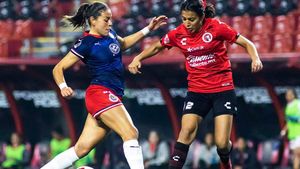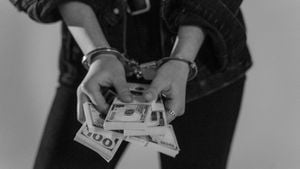Kendrick Lamar's Super Bowl LIX halftime performance on February 12, 2025, was not just another flashy display during the NFL's largest event of the year; it emerged as both a political statement and artistic commentary infused with hidden meanings. What unfolded on stage was not merely music, but rather complex narratives revolving around fame, social justice, and the artist's poignant conflicts, especially his long-gestated rivalry with fellow rapper Drake.
At the heart of Lamar's 13-minute performance was the bold declaration, "The revolution's about to be televised. You picked the right time but the wrong guy," echoing lines from Gil Scott-Heron’s poignant poem about the civil-rights movement and media's tendency to ignore such issues. This was Lamar's way of proclaiming his purpose on one of the biggest platforms available. He positioned himself as not just another performer, but as someone intent on broadcasting necessary truths, using the spectacle to foreground urgent conversations about race and inequality.
Yet, the performance was not without its interruptions. Toward the end of the show, one performer unfurled a hybrid flag combining the Sudanese and Palestinian flags, emblazoned with the words “Sudan” and “Gaza.” This unexpected act of protest led to immediate backlash from NFL officials. The league confirmed the individual was part of the show’s massive 400-member cast, claiming they were unaware of this planned action and affirmed, "The individual will be banned for life from all NFL stadiums and events."
Much vehement discussion erupted surrounding this incident. While some criticized it as inappropriate during such a high-profile event, advocacy groups like the Council on American-Islamic Relations praised the act as courageous and shedding light on significant geopolitical struggles. Their statement read, "This performer risked his career to peacefully raise awareness about human suffering without even causing any significant disruption to the halftime show, and he should be celebrated as a hero."
Returning to the halftime show, it was characterized by deliberate artistic motifs. Lamar's dancers, arrayed across the stage, formed the American flag, split right down the middle, symbolizing the political division roiling the nation. The stark imagery he employed was intentional, drawing on historical contexts - much like his lyric, "40 acres and mule, this is bigger than the music" - referring to the promises made to freed slaves but never fulfilled.
Instead of playing his greatest hits, Lamar's setlist was laden with recent tracks and diss songs showcasing his beef with Drake. During the performance, he teased fans by hinting at possibly performing his notorious diss track "Not Like Us," saying, "I wanna make a move. I wanna perform their favorite song. But you know they love to sue." This pointed jab came alongside the electrifying anticipation building up among fans, only to be playfully sidestepped as he launched instead, much to the joy and surprise, smoothly transitioning to the emotive duet "luther," featuring SZA.
This playful evasion captured the essence of Lamar's performance: ambition interspersed with gleeful malice toward those he criticizes, including tensions around his public rivalry with Drake. His choice of lyrics veered toward the confrontational, such as, "I get on they ass, yeah, somebody gotta do it," asserting his position, all the same, creating relatable yet unyielding critiques of contemporary celebrity culture. Such lines made it clear Lamar would not engage with measures typically expected during mainstream performances, showcasing his artistic autonomy.
Throughout the show, his visual narrative carried weighty criticism veiled beneath seemingly light-hearted fanfare: dancers donned outfits symbolizing America’s layered history—a blend of red, white, and blue envisioned through the lens of cultural struggle. The contrasting tones of his set were equally illuminating; for example, upon transitioning to "All the Stars," which featured softer themes, he shifted perspectives on societal expectations placed on black artists, summarizing the dichotomy of expectations versus reality within his artistry.
Interestingly, Samuel L. Jackson made a theatrical appearance, donning his Uncle Sam persona arguing for Lamar to tone down his performance. Jackson, embodying this layered character, highlighted pervasive constraints placed upon black voices within the industry, almost mocking the pressures placed on artists like Lamar to conform. He cautioned against being “too loud, too reckless, too ghetto,” touching upon the very forces Lamar challenges head-on. Here was the stage literally filled with visual metaphors, juxtaposed against the lyrics and undertones, allowing fans to see deeply embedded socio-political commentary.
Concluding the performance, Lamar's refrain echoed: "Game Over," adding yet another dimension to the show—representing both victory over forms of oppression and the seemingly never-ending challenge of reconciliation within societal constructs. The stage and design elements converted Lamar's showing to pop culture commentary, calling forth dialogue about American conditions both personal and societal.
Such commentary spun across social media platforms, igniting conversations about hip-hop’s enduring influence and Lamar’s deft navigation through modern turmoil. While some Twitter users bemoaned the lack of his classic tracks, others celebrated his refusal to play it safe, exclaiming his halftime show as revolutionary rather than ordinary entertainment. It became clear to audiences and commentators alike—this performance was not merely about music but firmly rooted within reflection on identity, cultural significance, and revenge through artistry.
By merging complex cultural discussions with the mainstream spectacle of the Super Bowl, Kendrick Lamar’s halftime show asserted the importance of artists using their platforms to challenge status quos. The show, infused with deep-seated meanings and audacious critiques, will undoubtedly be the subject of conversation long after the final whistle, ace the remarkable union of art, protest, and engagement on one of the biggest stages of our time.



